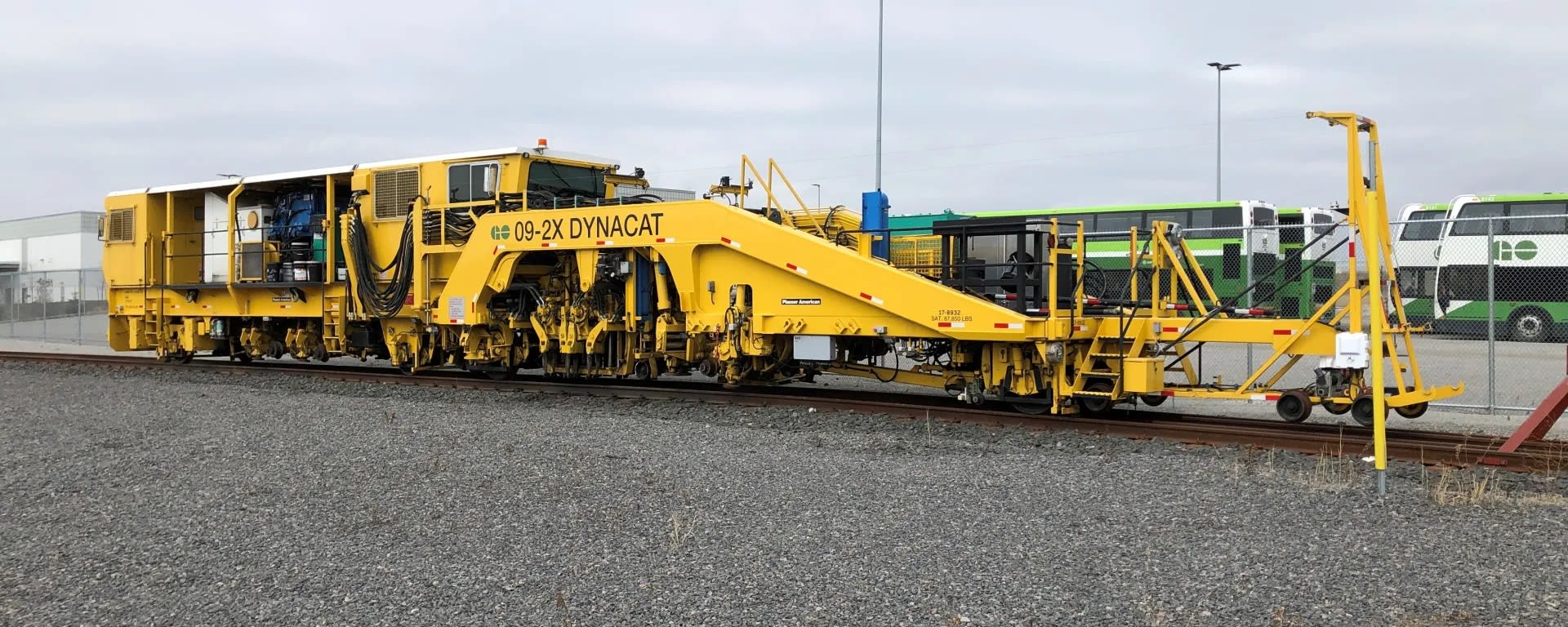Meet GO Transit’s massive track surfacing machine
Learn more about the Metrolinx-owned DynaCAT high production rail maintenance machine.
Apr 8, 2021
A smooth train ride can lull you right to sleep.
GO and UP Express customers quickly get used to the gentle sway of a train as it speeds down the tracks without knowing about the powerful brute that helps keep things flush and polished.
Making sure that GO and UP Express trains can travel at optimal speeds while keeping the ride smooth and comfortable is the result of regular maintenance work to keep tracks properly profiled.
Fluctuating temperatures, exposure to extreme weather, and dozens of heavy trains rolling over the tracks every day can alter their geometry, which can cause a bumpier ride for passengers. Untreated for an extended period of time, these imperfections in the track may even require trains to reduce speeds through sections of track, potentially causing delays.
As part of its annual track maintenance, Metrolinx surfaces tracks across its owned rail corridors to correct these defects.
Meet the DynaCAT
Metrolinx owns a Plasser DynaCAT 09-2X – a modern, high production track surfacing machine that integrates the work traditionally performed by two machines – a tamper and a dynamic stabilizer – into one.
This allows for track surfacing to be completed more efficiently, which minimizes the work time required and ultimately produces a higher quality final product, reducing maintenance costs in the long run.
Here’s the Metrolinx-owned DynaCAT parked at the Whitby Rail Maintenance Facility. (Metrolinx photo)
The DynaCAT acts as a tamper machine that lifts both the steel rails and the wooden track ties into the correct position, and packs and consolidates the ballast (the small rocks under the tracks) underneath and around them to provide more stability and prevent settlement under tracks and switches.
The machine provides controlled and very accurate track adjustments by manipulating single or multiple ties at the same time, depending on the need at each location. It provides fully automated, computer controlled and accurate leveling and lining for the rails themselves to ensure smooth geometry.
Here are the DynaCAT’s tamping heads that adjust the rails and ties into the correct position and pack ballast underneath the track to prevent settlement. (Metrolinx photo)
Secondly, the DynaCAT also includes an integrated track stabilizer, which simulates the weight of a train locomotive passing over the surfaced portion of track. A track stabilizer ensures that any voids or rough spots in the track structure are smoothed out after the track has been lifted into the correct position.
The DynaCAT’s stabilizer wheels used to simulate the weight of a locomotive. (Metrolinx photo)
This video from Plasser American – the machine’s manufacturer, shows the Metrolinx-owned DynaCAT in action and how it combines both functions into one.
Check out this video showing just how the DynaCAT looks in action. (Plasser Canada Inc. video)
Using this high production, high speed machine allows maintenance crews to move through each work area quicker to lessen the impacts on service and nearby communities.
Noise and vibration
However, for all its benefits, the DynaCAT does weigh in at nearly 80 tonnes and with the number of moving parts and the amount of heavy lifting it does, you cannot miss it while it’s operating.
Residents who live near the rail corridors where it’s working can expect to experience increased levels of noise and vibration.
Working the night shift
Also, because the DynaCAT cannot work while trains are operating – especially on single-track corridors – and the fact that during hot weather, track surfacing cannot be performed due to the risk of tracks buckling, most of this work has to take place at night.
Between mid-April and mid-May, the DynaCAT will begin working on the Kitchener corridor between Strachan Avenue in Toronto and just east of Bramalea GO Station in Brampton.
During the second half of May, the DynaCAT will travel to the Union Station rail corridor, the nearly five kilometre sections of track directly east and west of Union Station, where it will be working between Bathurst Street and the Don River.
Beginning in early June, the DynaCAT will travel up the Barrie corridor, where it will be working at various locations between Aurora and Bradford.
In late June and early July, the DynaCAT will travel up the Kitchener corridor again where it will surface a very long stretch of track between Georgetown GO Station and west of Kitchener GO Station. This work will be completed in September.
All track surfacing work is weather dependant. Precise work schedules may also vary depending on progress and track availability.
To receive detailed updates about track maintenance work like this and about other Metrolinx projects near you, please sign up for regional newsletters at Metrolinx.com/newsletter.
by Robert Pasiak Metrolinx senior advisor, Communications and Community Relations
